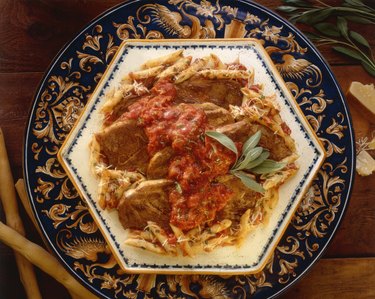Dinner is a formal event in Italy, where it is as important for the table arrangement to entice the eye as it is for the meal to please the palate. Complete settings with patterned or colorful dinnerware are the standard for formal dinners. Italian cooking, especially country cooking, places an emphasis on using fresh ingredients in simple combinations. Accordingly, centerpieces and place settings for an Italian dinner typically feature fresh fruits, vegetables and garden greenery.

Video of the Day
Things You'll Need
Silverware
Dinnerware
Centerpiece Supplies (Fruits, Vegetables, Leaves, Straw)
Water Goblets
Place Setting (Potted Plant, Flower)
Wine Goblets
Tablecloth
Votive Candles
Step 1
Place a tablecloth on your dining table. The color should coordinate with your dinnerware and your centerpiece. For a classic elegant look, white or bone is appropriate and allows you to make a fruit, vegetable or greenery centerpiece the focal point. It also lets more colorful place settings and table decor take center stage. If you have an attractive marble-top table, you can do without the tablecloth, as in some Italian bistros, especially if the dinner is less formal.
Video of the Day
Step 2
Create a centerpiece for your table. For an Italian table setting, centerpieces made with fresh fruit and greens will entice your guests, giving them a glimpse of the fresh food to come. Choose fruits based on the season and the color scheme. Lemons and limes over a straw or branch wreath add a spot of color and elegant shape. Tuck garden leaves in-between the fruit to fill the arrangement, and place an artichoke in the center. You can also use apples, oranges, pineapple, pumpkin, squash or bananas.
Step 3
Light candles for your dinner guests. Small clear votive holders with white candles create a white light. Place them one or two rows deep around the centerpiece, staggering them to create more visual depth.
Step 4
Create a place setting for each guest. An Italian dinner table often uses fresh fruits, vegetables or plants. Place a tiny potted succulent just outside the votive candles, on each setting. You can also cut a few layers off the bottom of an artichoke and lay it on the table. It resembles a large green blossom.
Step 5
Set out the dinnerware. If you have a choice for your dinnerware, look for patterns with an embellished pattern in several colors. These can evoke an Italian countryside feel. For a formal setting, each guest will have a large charger plate (this is larger than a dinner plate and typically used for decorative purposes only). A dinner plate sits atop the charger plate, with an antipasto plate above that. A salad plate can be put to the side of the main setting. You can place a cup and saucer in front of the guest's plate, on the right-hand side.
Step 6
Place silverware on either side of the setting. On the guest's left, place a salad fork on the outside, and a dinner fork on the inside. On the right, place a dinner spoon on the outside, a butter knife in the center, and a dinner knife directly next to the plate. Alternatively, place the dinner fork and spoon in front of the guest's plate stack (closest to the center of the table). Lay them horizontally, the fork below the spoon. The ends should be facing opposite directions.
Step 7
Set out the glasses. Each guest should have at least one water glass and wine goblet. You may offer two wine goblets so the guest can sample a red and white wine without using the same glass. Place these right in front of the plates to the guest's right.
Step 8
Fold and set out the napkins. Napkins should be linen, never paper. The Italian dinner table should not have paperware. Roll them lengthwise and place them atop the plate stack. You might also use a napkin ring, tie the napkin in a knot or simply fold it into a triangle and place it on the very left, next to the utensils.